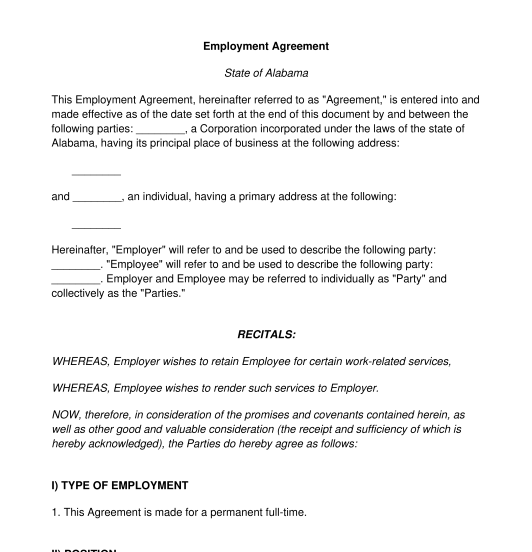 10/09/2025
10/09/2025

Answer a few questions and your document is created automatically.

Your document is ready! You will receive it in Word and PDF formats. You will be able to modify it.




Rating: 4.8 - 350 votes
Download a basic template (FREE) Create a customized documentAn employment agreement, sometimes called a work agreement, is a document used to hire someone to do work in exchange for monetary compensation. This forms the basis of an employment relationship between an employer and an employee.
Employment agreements allow both employers and employees to be protected in case there is a disagreement later on about something that may have been unclear between the parties. To get further information about the details that should be considered before creating the document, please refer to the guide Important Considerations for your Employment Agreement.
The main difference between these two contracts is the nature of the relationship created between the parties. Using an employment agreement creates an employee and employer relationship between the parties. The employer exerts much more control than in a service agreement, dictating the employee's hours, tax withholdings, and pay schedule. The employee typically receives employment benefits and their work is broader.
With a service agreement, the entity providing services is usually an external service provider. They control their own work schedule, finances, and taxes. They are not entitles to receive employment benefits, such as health insurance or a retirement account. The work they do is typically on one specific project or service.
For more information on this, please refer to the guide What's the Difference Between an Employee and an Independent Contractor.
Though both documents are used when bringing on a new employee, they are used at different points in the process. The employee offer letter is used by the employer to let the potential employee that they are being offered a job. It may contain details of the benefits that come with the job, but does not include the full terms of the agreement.
An employment agreement is used once the employee has accepted the position and has negotiated the terms of their agreement with the employer. The employment agreement outlines the full scope of the responsibilities that come with the job.
No, it is not mandatory to have an employee agreement. However, it is highly advisable as it makes sure that both the employee and employer have a clear idea of the scope of the employee's position responsibilities and the terms under which these will happen. It acts as protection for one or both of the parties in case there is a problem or future dispute related to the arrangement.
The probationary period is a period of time during which the employee will settle in at work and the parties will decide if the employment relationship is a good fit before completely committing.
A non-compete clause restricts the employee from working for competitors or starting a competing business in the same industry. This restriction is typically limited to a specific geographic location. It remains in force for a specified period of time after the employee leaves the employer's company.
Although non-compete clauses are allowed to be in employment agreements, non-compete clauses that are judged by a court to be too restrictive, either in geographic scope or time frame, may be determined to be unenforceable. If the employment agreement contains a non-compete clause, the following elements should be considered:
For more information about the enforceability of non-compete clauses, please refer to the guide "What is the Enforceability of Non-Competes in my State?"
Before the signing of the employment agreement, a formal offer of employment should be made to the employee. This is typically done using an employment offer letter.
An employment agreement is made between an employee and an employer. The employee is an individual person that must be 18 years of age or older. The employer can be either an individual person or a company.
The duration of an employment agreement can vary depending on the nature of the job and the needs of the employer. The most common term of employment is known as at-will employment. In this arrangement, there is no specified end date to the employment relationship and can be terminated by either the employer or employee at any time.
When the employment agreement is written and all the relevant information has been included, the document should be printed out and signed by both the employee and employer. Both parties should keep a copy of the document for their own reference in case of future misunderstanding or dispute.
A valid employment agreement must include at least the following mandatory clauses:
In addition to the above mandatory clauses, the following information may also be included:
Employment and employment agreements in the United States are subject to both federal laws and specific state laws. For example, the federal Fair Labor Standards Act (FLSA) covers wages and overtime pay for certain sectors. State laws, however, may define and restrict how employers can protect themselves if an employee tries to take their clients or use confidential information. The FLSA also sets wage, hours worked, and safety requirements for minors (individuals under age 18) working in jobs covered by the statute. The rules vary depending upon the particular age of the minor and the particular job involved. As a general rule, the FLSA sets 14 years old as the minimum age for employment, and limits the number of hours worked by minors under the age of 16.
You fill out a form. The document is created before your eyes as you respond to the questions.
At the end, you receive it in Word and PDF formats. You can modify it and reuse it.
Guides to help you
Employment Agreement - FREE - Template - Word & PDF
Country: United States